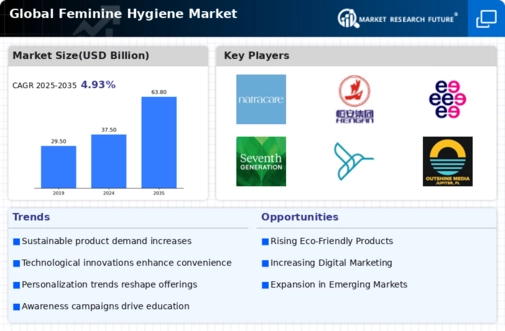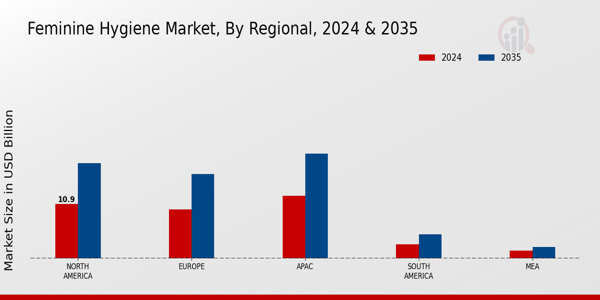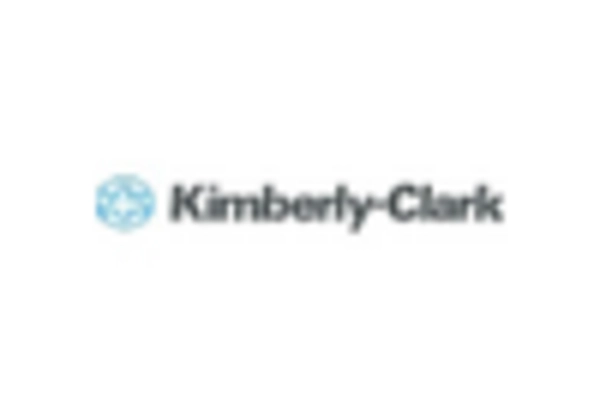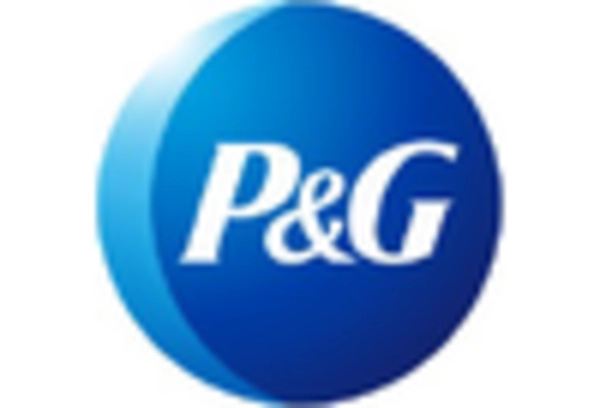-
EXECUTIVE SUMMARY
-
Market Overview
-
Key Findings
-
Market Segmentation
-
Competitive Landscape
-
Challenges and Opportunities
-
Future Outlook
-
\r\n
-
MARKET INTRODUCTION
-
Definition
-
Scope of the study
- Research Objective
- Assumption
- Limitations
-
RESEARCH METHODOLOGY
-
Overview
-
Data Mining
-
Secondary Research
-
Primary Research
- Primary Interviews and Information Gathering Process
- Breakdown of Primary Respondents
-
Forecasting Model
-
Market Size Estimation
- Bottom-Up Approach
- Top-Down Approach
-
Data Triangulation
-
Validation
-
\r\n
-
MARKET DYNAMICS
-
Overview
-
Drivers
-
Restraints
-
Opportunities
-
MARKET FACTOR ANALYSIS
-
Value chain Analysis
-
Porter's Five Forces Analysis
- Bargaining Power of Suppliers
- Bargaining Power of Buyers
- Threat of New Entrants
- Threat of Substitutes
- Intensity of Rivalry
-
COVID-19 Impact Analysis
- Market Impact Analysis
- Regional Impact
- Opportunity and Threat Analysis
-
\r\n
-
FEMININE HYGIENE MARKET, BY PRODUCT TYPE (USD BILLION)
-
Sanitary Napkins
-
Tampons
-
Menstrual Cups
-
Panty Liners
-
FEMININE HYGIENE MARKET, BY DISTRIBUTION CHANNEL (USD BILLION)
-
Supermarkets
-
Pharmacies
-
Online Stores
-
Convenience Stores
-
FEMININE HYGIENE MARKET, BY MATERIAL (USD BILLION)
-
Cotton
-
Synthetic
-
Biodegradable
-
FEMININE HYGIENE MARKET, BY END USER (USD BILLION)
-
Teenagers
-
Adults
-
Older Women
-
FEMININE HYGIENE MARKET, BY REGIONAL (USD BILLION)
-
North America
- US
- Canada
-
Europe
- Germany
- UK
- France
- Russia
- Italy
- Spain
- Rest of Europe
-
APAC
- China
- India
- Japan
- South Korea
- Malaysia
- Thailand
- Indonesia
- Rest of APAC
-
South America
- Brazil
- Mexico
- Argentina
- Rest of South America
-
MEA
- GCC Countries
- South Africa
- Rest of MEA
-
\r\n
-
COMPETITIVE LANDSCAPE
-
Overview
-
Competitive Analysis
-
Market share Analysis
-
Major Growth Strategy in the Feminine Hygiene Market
-
Competitive Benchmarking
-
Leading Players in Terms of Number of Developments in the Feminine Hygiene Market
-
Key developments and growth strategies
- New Product Launch/Service Deployment
- Merger & Acquisitions
- Joint Ventures
-
Major Players Financial Matrix
- Sales and Operating Income
- Major Players R&D Expenditure. 2023
-
COMPANY PROFILES
-
Always
- Financial Overview
- Products Offered
- Key Developments
- SWOT Analysis
- Key Strategies
-
Hengan International
- Financial Overview
- Products Offered
- Key Developments
- SWOT Analysis
- Key Strategies
-
Medline Industries
- Financial Overview
- Products Offered
- Key Developments
- SWOT Analysis
- Key Strategies
-
Edgewell Personal Care
- Financial Overview
- Products Offered
- Key Developments
- SWOT Analysis
- Key Strategies
-
KimberlyClark
- Financial Overview
- Products Offered
- Key Developments
- SWOT Analysis
- Key Strategies
-
Organyc
- Financial Overview
- Products Offered
- Key Developments
- SWOT Analysis
- Key Strategies
-
Laurier
- Financial Overview
- Products Offered
- Key Developments
- SWOT Analysis
- Key Strategies
-
Natracare
- Financial Overview
- Products Offered
- Key Developments
- SWOT Analysis
- Key Strategies
-
Cottonelle
- Financial Overview
- Products Offered
- Key Developments
- SWOT Analysis
- Key Strategies
-
Unicharm
- Financial Overview
- Products Offered
- Key Developments
- SWOT Analysis
- Key Strategies
-
LilLets
- Financial Overview
- Products Offered
- Key Developments
- SWOT Analysis
- Key Strategies
-
Bella
- Financial Overview
- Products Offered
- Key Developments
- SWOT Analysis
- Key Strategies
-
Seventh Generation
- Financial Overview
- Products Offered
- Key Developments
- SWOT Analysis
- Key Strategies
-
Johnson & Johnson
- Financial Overview
- Products Offered
- Key Developments
- SWOT Analysis
- Key Strategies
-
Procter & Gamble
- Financial Overview
- Products Offered
- Key Developments
- SWOT Analysis
- Key Strategies
-
APPENDIX
-
References
-
Related Reports
-
LIST OF TABLES
-
\r\n
-
LIST OF ASSUMPTIONS
-
NORTH AMERICA FEMININE HYGIENE MARKET SIZE ESTIMATES & FORECAST, BY PRODUCT TYPE, 2019-2035 (USD BILLIONS)
-
NORTH AMERICA FEMININE HYGIENE MARKET SIZE ESTIMATES & FORECAST, BY DISTRIBUTION CHANNEL, 2019-2035 (USD BILLIONS)
-
NORTH AMERICA FEMININE HYGIENE MARKET SIZE ESTIMATES & FORECAST, BY MATERIAL, 2019-2035 (USD BILLIONS)
-
NORTH AMERICA FEMININE HYGIENE MARKET SIZE ESTIMATES & FORECAST, BY END USER, 2019-2035 (USD BILLIONS)
-
NORTH AMERICA FEMININE HYGIENE MARKET SIZE ESTIMATES & FORECAST, BY REGIONAL, 2019-2035 (USD BILLIONS)
-
US FEMININE HYGIENE MARKET SIZE ESTIMATES & FORECAST, BY PRODUCT TYPE, 2019-2035 (USD BILLIONS)
-
US FEMININE HYGIENE MARKET SIZE ESTIMATES & FORECAST, BY DISTRIBUTION CHANNEL, 2019-2035 (USD BILLIONS)
-
US FEMININE HYGIENE MARKET SIZE ESTIMATES & FORECAST, BY MATERIAL, 2019-2035 (USD BILLIONS)
-
US FEMININE HYGIENE MARKET SIZE ESTIMATES & FORECAST, BY END USER, 2019-2035 (USD BILLIONS)
-
US FEMININE HYGIENE MARKET SIZE ESTIMATES & FORECAST, BY REGIONAL, 2019-2035 (USD BILLIONS)
-
CANADA FEMININE HYGIENE MARKET SIZE ESTIMATES & FORECAST, BY PRODUCT TYPE, 2019-2035 (USD BILLIONS)
-
CANADA FEMININE HYGIENE MARKET SIZE ESTIMATES & FORECAST, BY DISTRIBUTION CHANNEL, 2019-2035 (USD BILLIONS)
-
CANADA FEMININE HYGIENE MARKET SIZE ESTIMATES & FORECAST, BY MATERIAL, 2019-2035 (USD BILLIONS)
-
CANADA FEMININE HYGIENE MARKET SIZE ESTIMATES & FORECAST, BY END USER, 2019-2035 (USD BILLIONS)
-
CANADA FEMININE HYGIENE MARKET SIZE ESTIMATES & FORECAST, BY REGIONAL, 2019-2035 (USD BILLIONS)
-
EUROPE FEMININE HYGIENE MARKET SIZE ESTIMATES & FORECAST, BY PRODUCT TYPE, 2019-2035 (USD BILLIONS)
-
EUROPE FEMININE HYGIENE MARKET SIZE ESTIMATES & FORECAST, BY DISTRIBUTION CHANNEL, 2019-2035 (USD BILLIONS)
-
EUROPE FEMININE HYGIENE MARKET SIZE ESTIMATES & FORECAST, BY MATERIAL, 2019-2035 (USD BILLIONS)
-
EUROPE FEMININE HYGIENE MARKET SIZE ESTIMATES & FORECAST, BY END USER, 2019-2035 (USD BILLIONS)
-
EUROPE FEMININE HYGIENE MARKET SIZE ESTIMATES & FORECAST, BY REGIONAL, 2019-2035 (USD BILLIONS)
-
GERMANY FEMININE HYGIENE MARKET SIZE ESTIMATES & FORECAST, BY PRODUCT TYPE, 2019-2035 (USD BILLIONS)
-
GERMANY FEMININE HYGIENE MARKET SIZE ESTIMATES & FORECAST, BY DISTRIBUTION CHANNEL, 2019-2035 (USD BILLIONS)
-
GERMANY FEMININE HYGIENE MARKET SIZE ESTIMATES & FORECAST, BY MATERIAL, 2019-2035 (USD BILLIONS)
-
GERMANY FEMININE HYGIENE MARKET SIZE ESTIMATES & FORECAST, BY END USER, 2019-2035 (USD BILLIONS)
-
GERMANY FEMININE HYGIENE MARKET SIZE ESTIMATES & FORECAST, BY REGIONAL, 2019-2035 (USD BILLIONS)
-
UK FEMININE HYGIENE MARKET SIZE ESTIMATES & FORECAST, BY PRODUCT TYPE, 2019-2035 (USD BILLIONS)
-
UK FEMININE HYGIENE MARKET SIZE ESTIMATES & FORECAST, BY DISTRIBUTION CHANNEL, 2019-2035 (USD BILLIONS)
-
UK FEMININE HYGIENE MARKET SIZE ESTIMATES & FORECAST, BY MATERIAL, 2019-2035 (USD BILLIONS)
-
UK FEMININE HYGIENE MARKET SIZE ESTIMATES & FORECAST, BY END USER, 2019-2035 (USD BILLIONS)
-
UK FEMININE HYGIENE MARKET SIZE ESTIMATES & FORECAST, BY REGIONAL, 2019-2035 (USD BILLIONS)
-
FRANCE FEMININE HYGIENE MARKET SIZE ESTIMATES & FORECAST, BY PRODUCT TYPE, 2019-2035 (USD BILLIONS)
-
FRANCE FEMININE HYGIENE MARKET SIZE ESTIMATES & FORECAST, BY DISTRIBUTION CHANNEL, 2019-2035 (USD BILLIONS)
-
FRANCE FEMININE HYGIENE MARKET SIZE ESTIMATES & FORECAST, BY MATERIAL, 2019-2035 (USD BILLIONS)
-
FRANCE FEMININE HYGIENE MARKET SIZE ESTIMATES & FORECAST, BY END USER, 2019-2035 (USD BILLIONS)
-
FRANCE FEMININE HYGIENE MARKET SIZE ESTIMATES & FORECAST, BY REGIONAL, 2019-2035 (USD BILLIONS)
-
RUSSIA FEMININE HYGIENE MARKET SIZE ESTIMATES & FORECAST, BY PRODUCT TYPE, 2019-2035 (USD BILLIONS)
-
RUSSIA FEMININE HYGIENE MARKET SIZE ESTIMATES & FORECAST, BY DISTRIBUTION CHANNEL, 2019-2035 (USD BILLIONS)
-
RUSSIA FEMININE HYGIENE MARKET SIZE ESTIMATES & FORECAST, BY MATERIAL, 2019-2035 (USD BILLIONS)
-
RUSSIA FEMININE HYGIENE MARKET SIZE ESTIMATES & FORECAST, BY END USER, 2019-2035 (USD BILLIONS)
-
RUSSIA FEMININE HYGIENE MARKET SIZE ESTIMATES & FORECAST, BY REGIONAL, 2019-2035 (USD BILLIONS)
-
ITALY FEMININE HYGIENE MARKET SIZE ESTIMATES & FORECAST, BY PRODUCT TYPE, 2019-2035 (USD BILLIONS)
-
ITALY FEMININE HYGIENE MARKET SIZE ESTIMATES & FORECAST, BY DISTRIBUTION CHANNEL, 2019-2035 (USD BILLIONS)
-
ITALY FEMININE HYGIENE MARKET SIZE ESTIMATES & FORECAST, BY MATERIAL, 2019-2035 (USD BILLIONS)
-
ITALY FEMININE HYGIENE MARKET SIZE ESTIMATES & FORECAST, BY END USER, 2019-2035 (USD BILLIONS)
-
ITALY FEMININE HYGIENE MARKET SIZE ESTIMATES & FORECAST, BY REGIONAL, 2019-2035 (USD BILLIONS)
-
SPAIN FEMININE HYGIENE MARKET SIZE ESTIMATES & FORECAST, BY PRODUCT TYPE, 2019-2035 (USD BILLIONS)
-
SPAIN FEMININE HYGIENE MARKET SIZE ESTIMATES & FORECAST, BY DISTRIBUTION CHANNEL, 2019-2035 (USD BILLIONS)
-
SPAIN FEMININE HYGIENE MARKET SIZE ESTIMATES & FORECAST, BY MATERIAL, 2019-2035 (USD BILLIONS)
-
SPAIN FEMININE HYGIENE MARKET SIZE ESTIMATES & FORECAST, BY END USER, 2019-2035 (USD BILLIONS)
-
SPAIN FEMININE HYGIENE MARKET SIZE ESTIMATES & FORECAST, BY REGIONAL, 2019-2035 (USD BILLIONS)
-
REST OF EUROPE FEMININE HYGIENE MARKET SIZE ESTIMATES & FORECAST, BY PRODUCT TYPE, 2019-2035 (USD BILLIONS)
-
REST OF EUROPE FEMININE HYGIENE MARKET SIZE ESTIMATES & FORECAST, BY DISTRIBUTION CHANNEL, 2019-2035 (USD BILLIONS)
-
REST OF EUROPE FEMININE HYGIENE MARKET SIZE ESTIMATES & FORECAST, BY MATERIAL, 2019-2035 (USD BILLIONS)
-
REST OF EUROPE FEMININE HYGIENE MARKET SIZE ESTIMATES & FORECAST, BY END USER, 2019-2035 (USD BILLIONS)
-
REST OF EUROPE FEMININE HYGIENE MARKET SIZE ESTIMATES & FORECAST, BY REGIONAL, 2019-2035 (USD BILLIONS)
-
APAC FEMININE HYGIENE MARKET SIZE ESTIMATES & FORECAST, BY PRODUCT TYPE, 2019-2035 (USD BILLIONS)
-
APAC FEMININE HYGIENE MARKET SIZE ESTIMATES & FORECAST, BY DISTRIBUTION CHANNEL, 2019-2035 (USD BILLIONS)
-
APAC FEMININE HYGIENE MARKET SIZE ESTIMATES & FORECAST, BY MATERIAL, 2019-2035 (USD BILLIONS)
-
APAC FEMININE HYGIENE MARKET SIZE ESTIMATES & FORECAST, BY END USER, 2019-2035 (USD BILLIONS)
-
APAC FEMININE HYGIENE MARKET SIZE ESTIMATES & FORECAST, BY REGIONAL, 2019-2035 (USD BILLIONS)
-
CHINA FEMININE HYGIENE MARKET SIZE ESTIMATES & FORECAST, BY PRODUCT TYPE, 2019-2035 (USD BILLIONS)
-
CHINA FEMININE HYGIENE MARKET SIZE ESTIMATES & FORECAST, BY DISTRIBUTION CHANNEL, 2019-2035 (USD BILLIONS)
-
CHINA FEMININE HYGIENE MARKET SIZE ESTIMATES & FORECAST, BY MATERIAL, 2019-2035 (USD BILLIONS)
-
CHINA FEMININE HYGIENE MARKET SIZE ESTIMATES & FORECAST, BY END USER, 2019-2035 (USD BILLIONS)
-
CHINA FEMININE HYGIENE MARKET SIZE ESTIMATES & FORECAST, BY REGIONAL, 2019-2035 (USD BILLIONS)
-
INDIA FEMININE HYGIENE MARKET SIZE ESTIMATES & FORECAST, BY PRODUCT TYPE, 2019-2035 (USD BILLIONS)
-
INDIA FEMININE HYGIENE MARKET SIZE ESTIMATES & FORECAST, BY DISTRIBUTION CHANNEL, 2019-2035 (USD BILLIONS)
-
INDIA FEMININE HYGIENE MARKET SIZE ESTIMATES & FORECAST, BY MATERIAL, 2019-2035 (USD BILLIONS)
-
INDIA FEMININE HYGIENE MARKET SIZE ESTIMATES & FORECAST, BY END USER, 2019-2035 (USD BILLIONS)
-
INDIA FEMININE HYGIENE MARKET SIZE ESTIMATES & FORECAST, BY REGIONAL, 2019-2035 (USD BILLIONS)
-
JAPAN FEMININE HYGIENE MARKET SIZE ESTIMATES & FORECAST, BY PRODUCT TYPE, 2019-2035 (USD BILLIONS)
-
JAPAN FEMININE HYGIENE MARKET SIZE ESTIMATES & FORECAST, BY DISTRIBUTION CHANNEL, 2019-2035 (USD BILLIONS)
-
JAPAN FEMININE HYGIENE MARKET SIZE ESTIMATES & FORECAST, BY MATERIAL, 2019-2035 (USD BILLIONS)
-
JAPAN FEMININE HYGIENE MARKET SIZE ESTIMATES & FORECAST, BY END USER, 2019-2035 (USD BILLIONS)
-
JAPAN FEMININE HYGIENE MARKET SIZE ESTIMATES & FORECAST, BY REGIONAL, 2019-2035 (USD BILLIONS)
-
SOUTH KOREA FEMININE HYGIENE MARKET SIZE ESTIMATES & FORECAST, BY PRODUCT TYPE, 2019-2035 (USD BILLIONS)
-
SOUTH KOREA FEMININE HYGIENE MARKET SIZE ESTIMATES & FORECAST, BY DISTRIBUTION CHANNEL, 2019-2035 (USD BILLIONS)
-
SOUTH KOREA FEMININE HYGIENE MARKET SIZE ESTIMATES & FORECAST, BY MATERIAL, 2019-2035 (USD BILLIONS)
-
SOUTH KOREA FEMININE HYGIENE MARKET SIZE ESTIMATES & FORECAST, BY END USER, 2019-2035 (USD BILLIONS)
-
SOUTH KOREA FEMININE HYGIENE MARKET SIZE ESTIMATES & FORECAST, BY REGIONAL, 2019-2035 (USD BILLIONS)
-
MALAYSIA FEMININE HYGIENE MARKET SIZE ESTIMATES & FORECAST, BY PRODUCT TYPE, 2019-2035 (USD BILLIONS)
-
MALAYSIA FEMININE HYGIENE MARKET SIZE ESTIMATES & FORECAST, BY DISTRIBUTION CHANNEL, 2019-2035 (USD BILLIONS)
-
MALAYSIA FEMININE HYGIENE MARKET SIZE ESTIMATES & FORECAST, BY MATERIAL, 2019-2035 (USD BILLIONS)
-
MALAYSIA FEMININE HYGIENE MARKET SIZE ESTIMATES & FORECAST, BY END USER, 2019-2035 (USD BILLIONS)
-
MALAYSIA FEMININE HYGIENE MARKET SIZE ESTIMATES & FORECAST, BY REGIONAL, 2019-2035 (USD BILLIONS)
-
THAILAND FEMININE HYGIENE MARKET SIZE ESTIMATES & FORECAST, BY PRODUCT TYPE, 2019-2035 (USD BILLIONS)
-
THAILAND FEMININE HYGIENE MARKET SIZE ESTIMATES & FORECAST, BY DISTRIBUTION CHANNEL, 2019-2035 (USD BILLIONS)
-
THAILAND FEMININE HYGIENE MARKET SIZE ESTIMATES & FORECAST, BY MATERIAL, 2019-2035 (USD BILLIONS)
-
THAILAND FEMININE HYGIENE MARKET SIZE ESTIMATES & FORECAST, BY END USER, 2019-2035 (USD BILLIONS)
-
THAILAND FEMININE HYGIENE MARKET SIZE ESTIMATES & FORECAST, BY REGIONAL, 2019-2035 (USD BILLIONS)
-
INDONESIA FEMININE HYGIENE MARKET SIZE ESTIMATES & FORECAST, BY PRODUCT TYPE, 2019-2035 (USD BILLIONS)
-
INDONESIA FEMININE HYGIENE MARKET SIZE ESTIMATES & FORECAST, BY DISTRIBUTION CHANNEL, 2019-2035 (USD BILLIONS)
-
INDONESIA FEMININE HYGIENE MARKET SIZE ESTIMATES & FORECAST, BY MATERIAL, 2019-2035 (USD BILLIONS)
-
INDONESIA FEMININE HYGIENE MARKET SIZE ESTIMATES & FORECAST, BY END USER, 2019-2035 (USD BILLIONS)
-
INDONESIA FEMININE HYGIENE MARKET SIZE ESTIMATES & FORECAST, BY REGIONAL, 2019-2035 (USD BILLIONS)
-
REST OF APAC FEMININE HYGIENE MARKET SIZE ESTIMATES & FORECAST, BY PRODUCT TYPE, 2019-2035 (USD BILLIONS)
-
REST OF APAC FEMININE HYGIENE MARKET SIZE ESTIMATES & FORECAST, BY DISTRIBUTION CHANNEL, 2019-2035 (USD BILLIONS)
-
REST OF APAC FEMININE HYGIENE MARKET SIZE ESTIMATES & FORECAST, BY MATERIAL, 2019-2035 (USD BILLIONS)
-
REST OF APAC FEMININE HYGIENE MARKET SIZE ESTIMATES & FORECAST, BY END USER, 2019-2035 (USD BILLIONS)
-
REST OF APAC FEMININE HYGIENE MARKET SIZE ESTIMATES & FORECAST, BY REGIONAL, 2019-2035 (USD BILLIONS)
-
SOUTH AMERICA FEMININE HYGIENE MARKET SIZE ESTIMATES & FORECAST, BY PRODUCT TYPE, 2019-2035 (USD BILLIONS)
-
SOUTH AMERICA FEMININE HYGIENE MARKET SIZE ESTIMATES & FORECAST, BY DISTRIBUTION CHANNEL, 2019-2035 (USD BILLIONS)
-
SOUTH AMERICA FEMININE HYGIENE MARKET SIZE ESTIMATES & FORECAST, BY MATERIAL, 2019-2035 (USD BILLIONS)
-
SOUTH AMERICA FEMININE HYGIENE MARKET SIZE ESTIMATES & FORECAST, BY END USER, 2019-2035 (USD BILLIONS)
-
SOUTH AMERICA FEMININE HYGIENE MARKET SIZE ESTIMATES & FORECAST, BY REGIONAL, 2019-2035 (USD BILLIONS)
-
BRAZIL FEMININE HYGIENE MARKET SIZE ESTIMATES & FORECAST, BY PRODUCT TYPE, 2019-2035 (USD BILLIONS)
-
BRAZIL FEMININE HYGIENE MARKET SIZE ESTIMATES & FORECAST, BY DISTRIBUTION CHANNEL, 2019-2035 (USD BILLIONS)
-
BRAZIL FEMININE HYGIENE MARKET SIZE ESTIMATES & FORECAST, BY MATERIAL, 2019-2035 (USD BILLIONS)
-
BRAZIL FEMININE HYGIENE MARKET SIZE ESTIMATES & FORECAST, BY END USER, 2019-2035 (USD BILLIONS)
-
BRAZIL FEMININE HYGIENE MARKET SIZE ESTIMATES & FORECAST, BY REGIONAL, 2019-2035 (USD BILLIONS)
-
MEXICO FEMININE HYGIENE MARKET SIZE ESTIMATES & FORECAST, BY PRODUCT TYPE, 2019-2035 (USD BILLIONS)
-
MEXICO FEMININE HYGIENE MARKET SIZE ESTIMATES & FORECAST, BY DISTRIBUTION CHANNEL, 2019-2035 (USD BILLIONS)
-
MEXICO FEMININE HYGIENE MARKET SIZE ESTIMATES & FORECAST, BY MATERIAL, 2019-2035 (USD BILLIONS)
-
MEXICO FEMININE HYGIENE MARKET SIZE ESTIMATES & FORECAST, BY END USER, 2019-2035 (USD BILLIONS)
-
MEXICO FEMININE HYGIENE MARKET SIZE ESTIMATES & FORECAST, BY REGIONAL, 2019-2035 (USD BILLIONS)
-
ARGENTINA FEMININE HYGIENE MARKET SIZE ESTIMATES & FORECAST, BY PRODUCT TYPE, 2019-2035 (USD BILLIONS)
-
ARGENTINA FEMININE HYGIENE MARKET SIZE ESTIMATES & FORECAST, BY DISTRIBUTION CHANNEL, 2019-2035 (USD BILLIONS)
-
ARGENTINA FEMININE HYGIENE MARKET SIZE ESTIMATES & FORECAST, BY MATERIAL, 2019-2035 (USD BILLIONS)
-
ARGENTINA FEMININE HYGIENE MARKET SIZE ESTIMATES & FORECAST, BY END USER, 2019-2035 (USD BILLIONS)
-
ARGENTINA FEMININE HYGIENE MARKET SIZE ESTIMATES & FORECAST, BY REGIONAL, 2019-2035 (USD BILLIONS)
-
REST OF SOUTH AMERICA FEMININE HYGIENE MARKET SIZE ESTIMATES & FORECAST, BY PRODUCT TYPE, 2019-2035 (USD BILLIONS)
-
REST OF SOUTH AMERICA FEMININE HYGIENE MARKET SIZE ESTIMATES & FORECAST, BY DISTRIBUTION CHANNEL, 2019-2035 (USD BILLIONS)
-
REST OF SOUTH AMERICA FEMININE HYGIENE MARKET SIZE ESTIMATES & FORECAST, BY MATERIAL, 2019-2035 (USD BILLIONS)
-
REST OF SOUTH AMERICA FEMININE HYGIENE MARKET SIZE ESTIMATES & FORECAST, BY END USER, 2019-2035 (USD BILLIONS)
-
REST OF SOUTH AMERICA FEMININE HYGIENE MARKET SIZE ESTIMATES & FORECAST, BY REGIONAL, 2019-2035 (USD BILLIONS)
-
MEA FEMININE HYGIENE MARKET SIZE ESTIMATES & FORECAST, BY PRODUCT TYPE, 2019-2035 (USD BILLIONS)
-
MEA FEMININE HYGIENE MARKET SIZE ESTIMATES & FORECAST, BY DISTRIBUTION CHANNEL, 2019-2035 (USD BILLIONS)
-
MEA FEMININE HYGIENE MARKET SIZE ESTIMATES & FORECAST, BY MATERIAL, 2019-2035 (USD BILLIONS)
-
MEA FEMININE HYGIENE MARKET SIZE ESTIMATES & FORECAST, BY END USER, 2019-2035 (USD BILLIONS)
-
MEA FEMININE HYGIENE MARKET SIZE ESTIMATES & FORECAST, BY REGIONAL, 2019-2035 (USD BILLIONS)
-
GCC COUNTRIES FEMININE HYGIENE MARKET SIZE ESTIMATES & FORECAST, BY PRODUCT TYPE, 2019-2035 (USD BILLIONS)
-
GCC COUNTRIES FEMININE HYGIENE MARKET SIZE ESTIMATES & FORECAST, BY DISTRIBUTION CHANNEL, 2019-2035 (USD BILLIONS)
-
GCC COUNTRIES FEMININE HYGIENE MARKET SIZE ESTIMATES & FORECAST, BY MATERIAL, 2019-2035 (USD BILLIONS)
-
GCC COUNTRIES FEMININE HYGIENE MARKET SIZE ESTIMATES & FORECAST, BY END USER, 2019-2035 (USD BILLIONS)
-
GCC COUNTRIES FEMININE HYGIENE MARKET SIZE ESTIMATES & FORECAST, BY REGIONAL, 2019-2035 (USD BILLIONS)
-
SOUTH AFRICA FEMININE HYGIENE MARKET SIZE ESTIMATES & FORECAST, BY PRODUCT TYPE, 2019-2035 (USD BILLIONS)
-
SOUTH AFRICA FEMININE HYGIENE MARKET SIZE ESTIMATES & FORECAST, BY DISTRIBUTION CHANNEL, 2019-2035 (USD BILLIONS)
-
SOUTH AFRICA FEMININE HYGIENE MARKET SIZE ESTIMATES & FORECAST, BY MATERIAL, 2019-2035 (USD BILLIONS)
-
SOUTH AFRICA FEMININE HYGIENE MARKET SIZE ESTIMATES & FORECAST, BY END USER, 2019-2035 (USD BILLIONS)
-
SOUTH AFRICA FEMININE HYGIENE MARKET SIZE ESTIMATES & FORECAST, BY REGIONAL, 2019-2035 (USD BILLIONS)
-
REST OF MEA FEMININE HYGIENE MARKET SIZE ESTIMATES & FORECAST, BY PRODUCT TYPE, 2019-2035 (USD BILLIONS)
-
REST OF MEA FEMININE HYGIENE MARKET SIZE ESTIMATES & FORECAST, BY DISTRIBUTION CHANNEL, 2019-2035 (USD BILLIONS)
-
REST OF MEA FEMININE HYGIENE MARKET SIZE ESTIMATES & FORECAST, BY MATERIAL, 2019-2035 (USD BILLIONS)
-
REST OF MEA FEMININE HYGIENE MARKET SIZE ESTIMATES & FORECAST, BY END USER, 2019-2035 (USD BILLIONS)
-
REST OF MEA FEMININE HYGIENE MARKET SIZE ESTIMATES & FORECAST, BY REGIONAL, 2019-2035 (USD BILLIONS)
-
PRODUCT LAUNCH/PRODUCT DEVELOPMENT/APPROVAL
-
ACQUISITION/PARTNERSHIP
-
\r\n
-
\r\n
-
LIST OF FIGURES
-
\r\n
-
MARKET SYNOPSIS
-
NORTH AMERICA FEMININE HYGIENE MARKET ANALYSIS
-
US FEMININE HYGIENE MARKET ANALYSIS BY PRODUCT TYPE
-
US FEMININE HYGIENE MARKET ANALYSIS BY DISTRIBUTION CHANNEL
-
US FEMININE HYGIENE MARKET ANALYSIS BY MATERIAL
-
US FEMININE HYGIENE MARKET ANALYSIS BY END USER
-
US FEMININE HYGIENE MARKET ANALYSIS BY REGIONAL
-
CANADA FEMININE HYGIENE MARKET ANALYSIS BY PRODUCT TYPE
-
CANADA FEMININE HYGIENE MARKET ANALYSIS BY DISTRIBUTION CHANNEL
-
CANADA FEMININE HYGIENE MARKET ANALYSIS BY MATERIAL
-
CANADA FEMININE HYGIENE MARKET ANALYSIS BY END USER
-
CANADA FEMININE HYGIENE MARKET ANALYSIS BY REGIONAL
-
EUROPE FEMININE HYGIENE MARKET ANALYSIS
-
GERMANY FEMININE HYGIENE MARKET ANALYSIS BY PRODUCT TYPE
-
GERMANY FEMININE HYGIENE MARKET ANALYSIS BY DISTRIBUTION CHANNEL
-
GERMANY FEMININE HYGIENE MARKET ANALYSIS BY MATERIAL
-
GERMANY FEMININE HYGIENE MARKET ANALYSIS BY END USER
-
GERMANY FEMININE HYGIENE MARKET ANALYSIS BY REGIONAL
-
UK FEMININE HYGIENE MARKET ANALYSIS BY PRODUCT TYPE
-
UK FEMININE HYGIENE MARKET ANALYSIS BY DISTRIBUTION CHANNEL
-
UK FEMININE HYGIENE MARKET ANALYSIS BY MATERIAL
-
UK FEMININE HYGIENE MARKET ANALYSIS BY END USER
-
UK FEMININE HYGIENE MARKET ANALYSIS BY REGIONAL
-
FRANCE FEMININE HYGIENE MARKET ANALYSIS BY PRODUCT TYPE
-
FRANCE FEMININE HYGIENE MARKET ANALYSIS BY DISTRIBUTION CHANNEL
-
FRANCE FEMININE HYGIENE MARKET ANALYSIS BY MATERIAL
-
FRANCE FEMININE HYGIENE MARKET ANALYSIS BY END USER
-
FRANCE FEMININE HYGIENE MARKET ANALYSIS BY REGIONAL
-
RUSSIA FEMININE HYGIENE MARKET ANALYSIS BY PRODUCT TYPE
-
RUSSIA FEMININE HYGIENE MARKET ANALYSIS BY DISTRIBUTION CHANNEL
-
RUSSIA FEMININE HYGIENE MARKET ANALYSIS BY MATERIAL
-
RUSSIA FEMININE HYGIENE MARKET ANALYSIS BY END USER
-
RUSSIA FEMININE HYGIENE MARKET ANALYSIS BY REGIONAL
-
ITALY FEMININE HYGIENE MARKET ANALYSIS BY PRODUCT TYPE
-
ITALY FEMININE HYGIENE MARKET ANALYSIS BY DISTRIBUTION CHANNEL
-
ITALY FEMININE HYGIENE MARKET ANALYSIS BY MATERIAL
-
ITALY FEMININE HYGIENE MARKET ANALYSIS BY END USER
-
ITALY FEMININE HYGIENE MARKET ANALYSIS BY REGIONAL
-
SPAIN FEMININE HYGIENE MARKET ANALYSIS BY PRODUCT TYPE
-
SPAIN FEMININE HYGIENE MARKET ANALYSIS BY DISTRIBUTION CHANNEL
-
SPAIN FEMININE HYGIENE MARKET ANALYSIS BY MATERIAL
-
SPAIN FEMININE HYGIENE MARKET ANALYSIS BY END USER
-
SPAIN FEMININE HYGIENE MARKET ANALYSIS BY REGIONAL
-
REST OF EUROPE FEMININE HYGIENE MARKET ANALYSIS BY PRODUCT TYPE
-
REST OF EUROPE FEMININE HYGIENE MARKET ANALYSIS BY DISTRIBUTION CHANNEL
-
REST OF EUROPE FEMININE HYGIENE MARKET ANALYSIS BY MATERIAL
-
REST OF EUROPE FEMININE HYGIENE MARKET ANALYSIS BY END USER
-
REST OF EUROPE FEMININE HYGIENE MARKET ANALYSIS BY REGIONAL
-
APAC FEMININE HYGIENE MARKET ANALYSIS
-
CHINA FEMININE HYGIENE MARKET ANALYSIS BY PRODUCT TYPE
-
CHINA FEMININE HYGIENE MARKET ANALYSIS BY DISTRIBUTION CHANNEL
-
CHINA FEMININE HYGIENE MARKET ANALYSIS BY MATERIAL
-
CHINA FEMININE HYGIENE MARKET ANALYSIS BY END USER
-
CHINA FEMININE HYGIENE MARKET ANALYSIS BY REGIONAL
-
INDIA FEMININE HYGIENE MARKET ANALYSIS BY PRODUCT TYPE
-
INDIA FEMININE HYGIENE MARKET ANALYSIS BY DISTRIBUTION CHANNEL
-
INDIA FEMININE HYGIENE MARKET ANALYSIS BY MATERIAL
-
INDIA FEMININE HYGIENE MARKET ANALYSIS BY END USER
-
INDIA FEMININE HYGIENE MARKET ANALYSIS BY REGIONAL
-
JAPAN FEMININE HYGIENE MARKET ANALYSIS BY PRODUCT TYPE
-
JAPAN FEMININE HYGIENE MARKET ANALYSIS BY DISTRIBUTION CHANNEL
-
JAPAN FEMININE HYGIENE MARKET ANALYSIS BY MATERIAL
-
JAPAN FEMININE HYGIENE MARKET ANALYSIS BY END USER
-
JAPAN FEMININE HYGIENE MARKET ANALYSIS BY REGIONAL
-
SOUTH KOREA FEMININE HYGIENE MARKET ANALYSIS BY PRODUCT TYPE
-
SOUTH KOREA FEMININE HYGIENE MARKET ANALYSIS BY DISTRIBUTION CHANNEL
-
SOUTH KOREA FEMININE HYGIENE MARKET ANALYSIS BY MATERIAL
-
SOUTH KOREA FEMININE HYGIENE MARKET ANALYSIS BY END USER
-
SOUTH KOREA FEMININE HYGIENE MARKET ANALYSIS BY REGIONAL
-
MALAYSIA FEMININE HYGIENE MARKET ANALYSIS BY PRODUCT TYPE
-
MALAYSIA FEMININE HYGIENE MARKET ANALYSIS BY DISTRIBUTION CHANNEL
-
MALAYSIA FEMININE HYGIENE MARKET ANALYSIS BY MATERIAL
-
MALAYSIA FEMININE HYGIENE MARKET ANALYSIS BY END USER
-
MALAYSIA FEMININE HYGIENE MARKET ANALYSIS BY REGIONAL
-
THAILAND FEMININE HYGIENE MARKET ANALYSIS BY PRODUCT TYPE
-
THAILAND FEMININE HYGIENE MARKET ANALYSIS BY DISTRIBUTION CHANNEL
-
THAILAND FEMININE HYGIENE MARKET ANALYSIS BY MATERIAL
-
THAILAND FEMININE HYGIENE MARKET ANALYSIS BY END USER
-
THAILAND FEMININE HYGIENE MARKET ANALYSIS BY REGIONAL
-
INDONESIA FEMININE HYGIENE MARKET ANALYSIS BY PRODUCT TYPE
-
INDONESIA FEMININE HYGIENE MARKET ANALYSIS BY DISTRIBUTION CHANNEL
-
INDONESIA FEMININE HYGIENE MARKET ANALYSIS BY MATERIAL
-
INDONESIA FEMININE HYGIENE MARKET ANALYSIS BY END USER
-
INDONESIA FEMININE HYGIENE MARKET ANALYSIS BY REGIONAL
-
REST OF APAC FEMININE HYGIENE MARKET ANALYSIS BY PRODUCT TYPE
-
REST OF APAC FEMININE HYGIENE MARKET ANALYSIS BY DISTRIBUTION CHANNEL
-
REST OF APAC FEMININE HYGIENE MARKET ANALYSIS BY MATERIAL
-
REST OF APAC FEMININE HYGIENE MARKET ANALYSIS BY END USER
-
REST OF APAC FEMININE HYGIENE MARKET ANALYSIS BY REGIONAL
-
SOUTH AMERICA FEMININE HYGIENE MARKET ANALYSIS
-
BRAZIL FEMININE HYGIENE MARKET ANALYSIS BY PRODUCT TYPE
-
BRAZIL FEMININE HYGIENE MARKET ANALYSIS BY DISTRIBUTION CHANNEL
-
BRAZIL FEMININE HYGIENE MARKET ANALYSIS BY MATERIAL
-
BRAZIL FEMININE HYGIENE MARKET ANALYSIS BY END USER
-
BRAZIL FEMININE HYGIENE MARKET ANALYSIS BY REGIONAL
-
MEXICO FEMININE HYGIENE MARKET ANALYSIS BY PRODUCT TYPE
-
MEXICO FEMININE HYGIENE MARKET ANALYSIS BY DISTRIBUTION CHANNEL
-
MEXICO FEMININE HYGIENE MARKET ANALYSIS BY MATERIAL
-
MEXICO FEMININE HYGIENE MARKET ANALYSIS BY END USER
-
MEXICO FEMININE HYGIENE MARKET ANALYSIS BY REGIONAL
-
ARGENTINA FEMININE HYGIENE MARKET ANALYSIS BY PRODUCT TYPE
-
ARGENTINA FEMININE HYGIENE MARKET ANALYSIS BY DISTRIBUTION CHANNEL
-
ARGENTINA FEMININE HYGIENE MARKET ANALYSIS BY MATERIAL
-
ARGENTINA FEMININE HYGIENE MARKET ANALYSIS BY END USER
-
ARGENTINA FEMININE HYGIENE MARKET ANALYSIS BY REGIONAL
-
REST OF SOUTH AMERICA FEMININE HYGIENE MARKET ANALYSIS BY PRODUCT TYPE
-
REST OF SOUTH AMERICA FEMININE HYGIENE MARKET ANALYSIS BY DISTRIBUTION CHANNEL
-
REST OF SOUTH AMERICA FEMININE HYGIENE MARKET ANALYSIS BY MATERIAL
-
REST OF SOUTH AMERICA FEMININE HYGIENE MARKET ANALYSIS BY END USER
-
REST OF SOUTH AMERICA FEMININE HYGIENE MARKET ANALYSIS BY REGIONAL
-
MEA FEMININE HYGIENE MARKET ANALYSIS
-
GCC COUNTRIES FEMININE HYGIENE MARKET ANALYSIS BY PRODUCT TYPE
-
GCC COUNTRIES FEMININE HYGIENE MARKET ANALYSIS BY DISTRIBUTION CHANNEL
-
GCC COUNTRIES FEMININE HYGIENE MARKET ANALYSIS BY MATERIAL
-
GCC COUNTRIES FEMININE HYGIENE MARKET ANALYSIS BY END USER
-
GCC COUNTRIES FEMININE HYGIENE MARKET ANALYSIS BY REGIONAL
-
SOUTH AFRICA FEMININE HYGIENE MARKET ANALYSIS BY PRODUCT TYPE
-
SOUTH AFRICA FEMININE HYGIENE MARKET ANALYSIS BY DISTRIBUTION CHANNEL
-
SOUTH AFRICA FEMININE HYGIENE MARKET ANALYSIS BY MATERIAL
-
SOUTH AFRICA FEMININE HYGIENE MARKET ANALYSIS BY END USER
-
SOUTH AFRICA FEMININE HYGIENE MARKET ANALYSIS BY REGIONAL
-
REST OF MEA FEMININE HYGIENE MARKET ANALYSIS BY PRODUCT TYPE
-
REST OF MEA FEMININE HYGIENE MARKET ANALYSIS BY DISTRIBUTION CHANNEL
-
REST OF MEA FEMININE HYGIENE MARKET ANALYSIS BY MATERIAL
-
REST OF MEA FEMININE HYGIENE MARKET ANALYSIS BY END USER
-
REST OF MEA FEMININE HYGIENE MARKET ANALYSIS BY REGIONAL
-
KEY BUYING CRITERIA OF FEMININE HYGIENE MARKET
-
RESEARCH PROCESS OF MRFR
-
DRO ANALYSIS OF FEMININE HYGIENE MARKET
-
DRIVERS IMPACT ANALYSIS: FEMININE HYGIENE MARKET
-
RESTRAINTS IMPACT ANALYSIS: FEMININE HYGIENE MARKET
-
SUPPLY / VALUE CHAIN: FEMININE HYGIENE MARKET
-
FEMININE HYGIENE MARKET, BY PRODUCT TYPE, 2025 (% SHARE)
-
FEMININE HYGIENE MARKET, BY PRODUCT TYPE, 2019 TO 2035 (USD Billions)
-
FEMININE HYGIENE MARKET, BY DISTRIBUTION CHANNEL, 2025 (% SHARE)
-
FEMININE HYGIENE MARKET, BY DISTRIBUTION CHANNEL, 2019 TO 2035 (USD Billions)
-
FEMININE HYGIENE MARKET, BY MATERIAL, 2025 (% SHARE)
-
FEMININE HYGIENE MARKET, BY MATERIAL, 2019 TO 2035 (USD Billions)
-
FEMININE HYGIENE MARKET, BY END USER, 2025 (% SHARE)
-
FEMININE HYGIENE MARKET, BY END USER, 2019 TO 2035 (USD Billions)
-
FEMININE HYGIENE MARKET, BY REGIONAL, 2025 (% SHARE)
-
FEMININE HYGIENE MARKET, BY REGIONAL, 2019 TO 2035 (USD Billions)
-
BENCHMARKING OF MAJOR COMPETITORS
-
\r\n










Leave a Comment